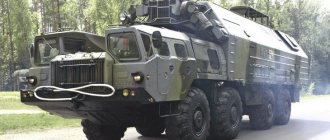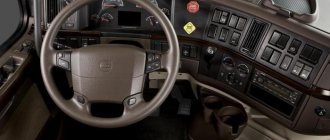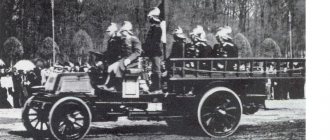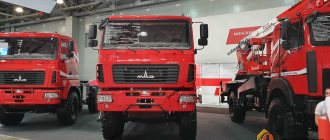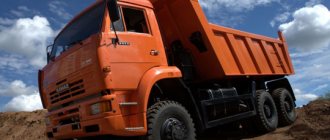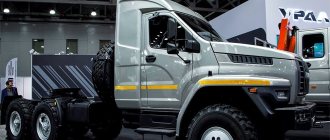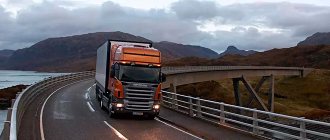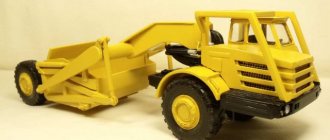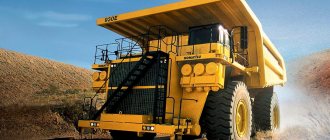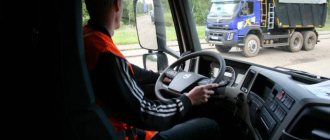The construction of the Minsk Automobile Plant was not planned. Before the war, there was a military unit in its place, and after the Nazi invasion, the occupiers built an automobile repair plant there. After the liberation of Minsk, production facilities were used to build a car assembly plant.
Soon, the production of diesel trucks from Yaroslavl was transferred to MAZ, and already in the 50s, the automobile plant began to launch series of vehicles of the most advanced design in the USSR. And a special design bureau at the plant began developing army trucks. One of them was the MAZ-537 tractor.
About the history of the model
The design of this mighty truck has been carried out since 1956, at the Special Design Bureau No. 1 of the Minsk Automobile Plant, in parallel with the development of “small” ballast tractors MAZ-535 and MAZ-536.
The main designer of the model was Boris Lvovich Shaposhnik, an experienced specialist, future Hero of Socialist Labor, who had previously led work on the models of heavy mining dump trucks MAZ-525 and MAZ-530; wheeled artillery tractors with an 8x8 wheel arrangement.
When creating the Minsk tractor-rocket carriers of the 535th and 537th models, the design bureau of Boris Shaposhnik, for the first time in the domestic mechanical engineering, developed and introduced into production an original hydromechanical transmission, a two-speed transfer case, and a bogie axle arrangement (2 plus 2); made the wheels of the two front axles steerable, used 7(!) differentials, independent suspension on all wheels, pneumatic-hydraulic brakes, and centralized tire inflation; designed an original trough-type frame.
The first MAZ-537 trucks were assembled at the end of 1958, and in March 1959 the model was launched into small-scale production. It continued in Minsk until 1964, after which the production of MAZ 537 series was transferred to the city of Kurgan. There, some changes were gradually made to the design of the vehicles, and they were produced under the brand name KZKT - Kurgan Wheel Tractor Plant.
The MAZ-537 was adopted by the Soviet Army on July 30, 1962, and some vehicles continue to serve in the 21st century, already as part of the Russian Army. The total number of such trucks produced in Minsk and Kurgan is not known for certain, but it is estimated at 8-10 thousand copies.
The changes that were made to the original design are not very significant. In particular, the air intake became box-shaped, the visibility of the road and the surrounding area was improved by increasing the area of the rear-view mirrors. The truck's fenders became flat and were extended to the middle axles. It became possible to get to the hitch and winch using a ladder.
Heavy-duty trailers, model 2-PPT-50, with a load capacity of 50 tons, were initially created especially for heavy trucks of the MAZ-537 family. Subsequently, as serial production of this truck model developed, more advanced trailers and special cargo platforms were developed and put into production.
The main application of MAZ-537 truck tractors with a permissible load on the coupling device of 25 tons is work as part of road trains with a gross weight of up to 90 tons and towing low-loading 65-ton semi-trailers for transporting heavy equipment, large indivisible cargo, various weapons systems and missile systems.
The first attempt to create a heavy tractor
The first thoughts about creating huge heavy tractors appeared among Soviet designers at the beginning of the Great Patriotic War, when two huge truck tractors were brought to the USSR under Lend-Lease:
- REO 28XS;
- Diamond T-980.
These tractors had a lifting capacity of up to 45 tons and were equipped with winches. Their main purpose was to transport tanks and other heavy armored vehicles.
Having received such powerful tractors, Soviet designers began to think about creating domestic vehicles based on them. In those years, Soviet tanks moved under their own power or were transported by rail. Although these methods were considered economically infeasible, there was simply no other alternative.
Immediately after the end of the Great Patriotic War, Soviet designers were given the task of developing a heavy tractor for military and commercial needs. In 1951, the Yaroslavl Automobile Plant produced the first heavy tractor equipped with a powerful winch. This development turned out to be unsuccessful, since the cross-country ability of the new development, called YAZ-210G, turned out to be very low. In spring and autumn, they could not even drive off-road without a load.
It turned out that by 1952, the Soviet Union still had an acute shortage of super-heavy tractors. Large-scale construction projects and the emergence of strategic missile systems, which needed constant deployment, urgently required measures to be taken to create heavy off-road tractors.
Design of the MAZ-537 tractor
In terms of technical characteristics, the MAZ-537 is very similar to the base model - MAZ-535, with a wheelbase increased by 300 mm and a track width expanded by up to 2200 mm.
The car frame is riveted-welded, reinforced, trough-shaped, with channel-section side members.
The four front steered wheels, like the MAZ-535, were suspended on an independent torsion bar suspension. In order to ensure enhanced strength and load-carrying capacity, the rear balancer suspension was composed of two powerful lateral longitudinally swinging arms, rigidly mounted on the frame.
The wheels are combined in pairs by balancers into a trolley, and are pivotally connected to the frame without any elastic element. The wheels are discless, 1600x500-610 (18.00-24″). Their rim 330-610 (13.00-14″) consists of three segments and is attached to the hub with clamps on ten studs. In order to increase the tractor's load-carrying capacity, it was decided to abandon the tire pressure regulation system. To replace 16-ply tires with adjustable air pressure, new 24-ply tube tires with constant pressure (4.5 kg/cm²) model I-170 with an “oblique dissected herringbone” tread pattern were specially developed.
The brakes on all wheels of this truck are drum type. The service brake system is equipped with a pneumohydraulic drive. The parking brake is a transmission brake, mounted on the transfer case, with a mechanical drive.
The steering mechanism is the same as on the MAZ-525: a screw-ball nut, with a gear ratio of 26.9. The hydraulic booster is piston type, with a built-in hydraulic distributor.
At the front of the frame there is a four-seat row cab with two doors on the sides and a hatch in the roof. On the front wall of the cabin there were initially three headlights with ventilation hatches between them, but then on production cars only two headlights were left, on the sides of which there were small fairings with sidelights. On both sides of the engine compartment there are 5 narrow and high air intake hatches with opening vertical flaps. Towing devices are mounted on the frame at the front and rear, and a V-shaped working platform (step) for the hitch is located between the middle axles.
Directly behind the cabin is the engine-transmission compartment, in which a twelve-cylinder tank diesel engine D-12A-525A is installed.
MAZ-537G of late production with open placement of fuel tanks
0
Structurally, the first Kurgan MAZ-537 cars were no different from the Minsk ones. They were equipped with the same 48-valve diesel engine D12A-525 V12 with a power of 525 hp. p., hydromechanical gearbox, drum brakes and independent torsion bar suspension. The two-door, four-seat all-metal cab was equipped with a sunroof and spotlight on the roof, two heaters, an adjustable driver's seat and two headlights, but three-headlight versions appeared as needed until the last editions. Spare wheels were usually placed on the free front part (trunk or jib) of standard low-bed semi-trailers of two main types - MAZ-5247G and ChMZAP-9990 with a carrying capacity of 50–52 tons.
0
MAZ-537G tractor with a three-axle tank semi-trailer ChMZAP-9990
Engine
The D-12A-525A diesel engine can rightfully be called a direct descendant of the V-2 engine from the glorious Soviet T-34 tank. This diesel engine has a power of 525 horsepower at 2000 rpm and a specific diesel fuel consumption of 176 g/hp/h. Working volume – 38880 cm3.
It embodied many important innovative solutions that are still used by global manufacturers of cars and other engine building equipment. These include four valves per cylinder, two overhead camshafts, direct injection of diesel fuel, dampers of torsional vibrations of the crankshaft, up to balancing 12th-order harmonics, and an engine lubrication system with a “dry” sump.
The D-12A-525A engine has a V-shaped cylinder arrangement, with a 60-degree camber of the blocks, and a crankshaft with six cranks. One main connecting rod is attached to each crankpin, and a trailing connecting rod is attached to it, that is, the cylinders of the right and left blocks are in the same plane. The counterweights do not sit rigidly on the crankshaft, but are suspended on the wings. This solution allows to balance torsional vibrations.
The D-12A-525A motor is equipped with a pre-heater, a double starting system and circulation lubrication.
Overhead The location of the camshafts is overhead; they are driven by the timing mechanism, and not by a belt or chain. The lubricant is in a separate tank. A three-section oil pump operates - one injection section and two pump-out sections. The crankshaft rotates without encountering resistance from the oil bath.
The power system is with direct injection of diesel fuel: a medium pressure pump supplies fuel to the unit injectors at 90 Bar (preliminary injection is performed) and the injector pump completes the job at 700 Bar (the main injection is performed). That is, we are seeing a solution to the decomposition-free combustion of diesel fuel in cylinders.
The diesel fuel pump D-12A-525A is equipped with a diesel fuel supply corrector to increase torque when the vehicle overcomes increased road resistance.
The starting system operates from both an electric starter and compressed air. You open the cylinder, turn the tap, and air is supplied through the distributor to the engine, according to the operating order of its cylinders. pressed on the pistons and set them in motion. After which the engine started.
The D12A-525A engine is equipped with an alternating current generator with a built-in rectifier, voltage regulator and radio interference suppression device.
Over the years of operation of the MAZ-537, the D-12A-525A engine has proven itself to be extremely reliable, unpretentious and trouble-free in operation. Although its motor life is small, especially by modern standards. The D-12A-525A was also equipped with multi-axle tractors MAZ-543, MAZ-7310, MAZ-74106, airfield tractors BelAZ-6422, BelAZ-7211.
The weight of the D12A-525A engine is 1540 kg. Its overall dimensions are 1575 x 1052 x 1070 (length x width x height). The assigned resource before major repairs is 1500 hours.
One of the modifications of the MAZ-537 was also equipped with the YaMZ-240NM, a twelve-cylinder V-shaped diesel engine with direct fuel injection, turbocharging, liquid cooling, 500 horsepower, designed for heavy mining dump trucks.
Modernization
After some time, the military MAZ 537 was modernized, and the car was given the index “P”. The technical specifications remained unchanged, but the winch was abolished, and the body was converted for transporting personnel. Along the folding sides, longitudinal benches and arches for the awning were installed, which were adjustable in height - in the lower position the awning covered the cargo, in the upper position it served as protection from rain and snow for people. In accordance with its intended purpose, the MAZ 537P tractor could tow platforms with missile systems.
The operation of wheeled tractors required maintenance specialists, qualified drivers and appropriate material resources. Therefore, in the 70s, specialized enterprises were formed for the centralized transportation of large-sized and extra-heavy cargo. The Spetstyazhavtotrans association was engaged in the transportation of non-standard cargo, while developing optimal routes. With the help of MAZ 537 tractors, a block of marble weighing 300 tons was transported for the construction of the monument to V.I. Lenin in Leningrad. The whole country watched this unique transport operation.
MAZ 537 tractors were widely used in the north, where oil and gas pipelines were being laid. The unpretentious machine has proven itself well in cold climates. The PV-481 pipe hauler was created specifically for the transportation of long gas-conducting joints based on the MAZ 537 towing vehicle. Also, for work in northern conditions, prototypes of fire engines, technical mobile units, and emergency medical all-terrain vehicles were created. However, test copies did not enter mass production.
In 1991, the Kurgan Wheel Tractor Plant began serial production of the KZKT-9101 heavy semi-trailer, with a lifting capacity of 54 tons, for the MAZ 537 towing vehicle, the technical characteristics of which completely coincided with the data of the semi-trailer. The combination of components turned out to be successful; customers were able to purchase both a tractor and a semi-trailer within one order.
Over the many years of production, MAZ 537 towing vehicles, photos of which are presented on the page, have gradually become outdated, both morally and technically. The machine has exhausted itself, the potential for further development has dried up. Previously hidden shortcomings began to appear, and the low service life of the power plant caused many complaints. The operation of the tractor was associated with frequent breaks for repairs; the army MAZ 537, when transporting tanks and other armored vehicles, did not accommodate the crew, who was forced to travel separately. To do this, it was necessary to attract additional cars.
In the end, on the basis of the 537th model, a new tractor KZKT-7428 was created, which fully met the tasks of transporting tracked combat vehicles. Currently, the family of powerful wheeled tractors successfully solves all problems of transporting heavy military equipment, as well as civilian large-sized industrial structures.
Transmission and axles of the MAZ-537 tractor
The transmission of this truck is hydromechanical, with a torque converter and a planetary three-speed gearbox.
In general, the MAZ-537 transmission includes a single-stage torque converter (four-wheeled, with pump and turbine wheels locked), a three-stage planetary gearbox with friction hydraulic gear shifting through a spool-type mechanism (gear ratios: I-3.2; II-1 .8; III-1.0; ZH-1.6); two-stage mechanical transfer case (with gear ratios: low gear - 1.88, high gear - 1.0). In 2nd and 3rd gears, the torque converter may be blocked.
The matching gear is a single-row three-shaft gearbox with a mechanism for disconnecting the hydromechanical transmission from the engine (an elastic coupling with rubber bushings), drives for the power steering pump, an additional compressor and engine fans and a hydromechanical gearbox (gear ratio - 0.867).
The steering mechanism of the truck is equipped with hydraulic power steering. The two front axles are steerable. The bridges are equipped with unequal velocity joints. To increase cross-country ability, the cross-axle differentials of the two front axles are designed as limited friction mechanisms, and the two rear axles are self-locking. Center differentials are locked. All wheels have non-disconnectable drive.
Each of the axles of this vehicle includes a central gearbox, two semi-axial cardans and two wheel planetary gears. The second front and second rear central gearboxes are made through. From them, torque is transmitted through cardan shafts to the central gearboxes of the front and first rear axles.
The differential of the front center gearboxes of the truck belongs to the limited slip differentials, and the differential of the rear center gearboxes belongs to the self-locking differentials, which operate on the principles of a freewheel.
Technical specifications in numbers
- Overall dimensions – length 8960 mm x width 2890 mm x height 2880 mm.
- Wheelbase – 6050 mm (1700+2650+1700 mm).
- Track width – 2200 mm.
- Ground clearance – 500 mm.
- The minimum turning radius of a single vehicle is 15.5 meters.
- The curb weight of the tractor is 21.6 tons.
- The total permissible weight is 47 tons.
- The total weight of the road train is 87 tons.
- The maximum speed of a single vehicle on the highway is 60 km/h, a road train is 55 km/h, and on regular roads is 25-30 km/h.
- The control consumption of diesel fuel is 125 liters per 100 km.
- The capacity of the fuel tanks is two tanks of 420 liters of diesel fuel.
- Power reserve – up to 650 km.
- Fording - 1 meter without preparation, 1.3 m with preparation.
- Overcoming climbs – 30º single vehicle, 8º road train.
Modification options for MAZ-537 (KZKT-537)
- MAZ-537 is the basic model of a truck tractor.
- MAZ-537A is a ballast tractor with a metal welded platform and a winch. It was intended for towing heavy artillery pieces, trailers and missile systems with a total weight of up to 75 tons along highways or over rough terrain.
- MAZ-537B is a tractor with a platform for placing the R-17 operational-tactical missile.
- MAZ-537V is a specialized truck tractor with a permissible load on the coupling device reduced by 7 tons. A design feature of this version of the tractor is the fifth-wheel coupling device, moved back by 345 mm due to the specific configuration of the towed loads. It was designed to transport unmanned reconnaissance aircraft DBR-1 "Yastreb" (Tu-123 UAV) on the two-axle SURD-1 platform and was produced in small batches according to special requests from the Ministry of Defense from 1965 to 1985. In addition to transporting UAVs, this modification was also used for towing special two-axle eight-wheel transport semi-trailers with containers for strategic missiles UR-100 and 5V 61 missiles (for firing systems of the A-Z5 missile defense system, as well as a two-axle tanker semi-trailer T3-ZO (AT3- ZO), with a capacity of up to thirty thousand liters.
- MAZ-537G is a multi-purpose universal truck tractor, with the load on the fifth wheel increased to 27 tons and a new 15-ton winch, for operation as part of road trains, with three-axle semi-trailers and MAZ-796 tank carriers and two-axle 50-ton multi-purpose semi-trailers brand MAZ-5247G. MAZ-537G trucks were used with any type of heavy military semi-trailers, towed all types of armored vehicles in service with the Soviet Army, missile systems and installation units, served as a base for KET-T evacuation tractors, MTP-A4 technical assistance vehicles and the basis for new generations of truck tractors . This modification is the most widespread, which was produced in Kurgan from 1964 until the collapse of the Soviet Union.
- MAZ-537D is a special-purpose truck tractor with an alternating current generator set. This modification was intended for transporting special semi-trailer systems of the Soviet missile forces, while simultaneously performing the functions of a mobile power station. After all, missile systems include numerous consumers of electricity.
- MAZ-537E is a specialized truck tractor for strategic missile forces. It was equipped with additional power take-off for auxiliary electric generators, hydraulic pumps and compressors to power various semi-trailer systems. This vehicle could tow semi-trailers with a total weight of up to 68 tons (in particular, 537 G) and perform work as part of road trains with a total weight of up to 90 tons. In the modified version, the truck was also used as a tractor-pusher and an additional source of electricity as part of a super-heavy multi-link transport and reloading road train 15T284, intended for transporting a container with an RT-2Z intercontinental ballistic missile.
- MAZ-537K is a tractor equipped with crane equipment. It was designed for the 9K76 Temp-S missile systems.
- MAZ-537T is a special modification for working in hot and humid climates. Unlike the base car, the MAZ-537T was equipped with protective coatings for all its main units, components and parts - in order to increase their anti-corrosion resistance and durability, using special materials and technologies. In particular, the torque converter parts were subjected to chemical oxidation, copper gaskets were tin-plated, bearing seats were chrome-plated, handles and control rods were cadmium-plated, cooling system tanks were anodized, etc.
- MAZ-537L is a special airfield tractor designed for towing aircraft weighing up to two hundred tons.
- KZKT-537M is an experimental tractor with a 500-horsepower YaMZ-240NM diesel engine.
- KZKT-537P is a universal missile system towing truck, equipped with an additional body with an awning and seats for personnel.
- MAZ-537R is a civilian version of the tractor, equipped with a power take-off gearbox and a TT-2 trailer. It was used as part of the PV-481 pipe haulers during the construction of oil and gas pipelines.
There were also very specific and bold versions of this truck. For example, in 1977, on the basis of the MAZ-537G tractor and the MAZ-9994 semi-trailer with a carrying capacity of 65 tons, on the initiative of Academician Vasily Brisovich Nesterenko, two mobile nuclear power plants “Pamir-630D” were created. After the Chernobyl disaster, this scientific project was closed, mobile nuclear power plants and tractors with equipment were disposed of.
As a result, the MAZ-537 truck gave way to more modern heavy-duty tractors of the KZKT-7428 model, which were developed back in the 1980s, before being rebuilt to replace the MAZ-537. This new family of tractors from the Kurgan plant still solves all issues related to the transportation of heavy military equipment and large-sized weapon systems of the Russian army.
But some MAZ-537s also still remain in service. Nowadays, trucks of this model can sometimes still be found not only in the army, but also in some civilian enterprises (in single copies): they are used to transport heavy crawler bulldozers, excavators, cranes, etc. special equipment.
Early MAZ-537G with a MAZ-5247G tank semi-trailer. 1967
0
After further modifications, they became the most popular towing vehicles for heavy semi-trailer systems and over time turned into the most common Soviet all-wheel drive tank tractors for delivering various tracked vehicles on highways and on terrain. Thanks to them, for the first time, the Soviet Army was able to quickly transport large armored formations along public roads and quickly deploy large armored formations without resorting to the services of a slow and vulnerable railway network.
